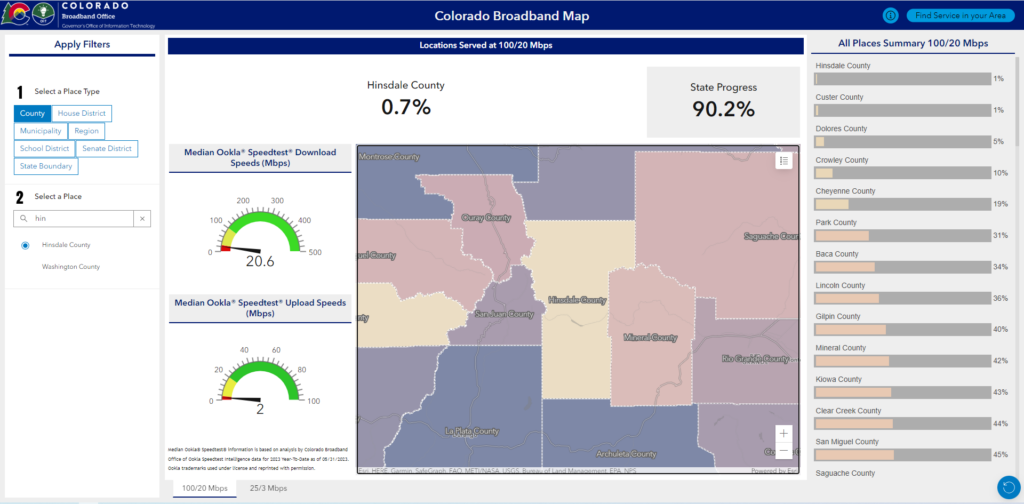Some areas of Colorado still don’t have high-speed internet, but new funding could change that
Some areas of Colorado still don't have high-speed internet, but new funding could change that Colorado Public Radio


Past attempts to connect all corners fell short
In 2000, then Republican Gov. Bill Owens touted $37 million for U.S. West — which then became Qwest, which got acquired by Centurylink, which is now Lumen — to connect all county seats within 10 years. It was nicknamed “the beanpole project.”
Ten years later, Silverton still didn’t have high-speed access. The fiber cables were about 16 miles short of the town when funding dried up.
In 2010, when Democrat Bill Ritter was governor, the state received $100 million from the American Recovery and Reinvestment Act to connect almost 200 school districts. (That project was called Eagle net). So in 2014, helicopters placed fiber lines along electrical lines to try and connect to Silverton. but even that fell short.
“That got laid all the way just outside of town,” Gallegos recalled with a chuckle. “And now we as a community are responsible for figuring out how do we tether to that amazing opportunity that’s just right outside of our town.”
Sen. John Hickenlooper, the state’s former governor, said geography has been a challenge. “Colorado’s full of box canyons and you go from the plains and then suddenly you’re in the hill country, then you’re in mountains…So we end up having to run more fiber longer distances than maybe some other states would.”
It’s a literal embodiment of what many call “the last mile problem.”
For so long we have struggled to convince providers to build that last mile,” said Democratic Rep. Joe Neguse, especially in hard to reach places. Despite past promises that failed to deliver, he sees the $826 million from the infrastructure law as a game changer, “because now the federal government, by virtue of the investments we are making, will ensure that that last mile is connected.”
It took almost a quarter of a century, but Silverton was able to get another provider besides Centurylink, now known as Lumen, in and there is some high-speed internet available, but it’s still not everywhere. For example, the Visitor’s Center still relies on the old dial-up system, which is currently out. And Gallegos said Centurylink wouldn’t be able to send a technician to fix it until September.
“It kind of all almost forces you to start exploring the other options in our community,” she said.
Centurylink did not respond to requests for comment.
Money is just one obstacle to spreading broadband across the state
A plethora of three- and four-letter state and federal agencies have spent millions of dollars expanding high-speed internet across the state: DOLA, the BDB, the FCC, NTIA and USDA to name a few. And since the pandemic, the number has grown larger. The state has received $1.2 billion to beef up high-speed internet access.
The big question now is how to best use those funds to get all of the state connected. As past attempts have shown, money has been just one obstacle to spreading broadband across the state. Another has been figuring who to work with; Early attempts focused on big internet providers to do the work.
“We kept subsidizing the largest telecommunications companies in America,” explained Democratic Sen. Michael Bennet, “and said to them, to the tune of $50 billion, ‘Please go out there and build broadband for the American people.’ And they never did, especially in rural America.”
Over in Hinsdale County, another sparsely populated remote county, about one percent of homes and businesses have 100/20 Mbps, while just under 60 percent have 25/3 Mbps, per the Colorado Broadband Office’s map. (The first number is the download speed and the second is for uploads).

Commissioner Greg Levine, who manages the broadband portfolio, said big companies like CenturyLink didn’t give communities what they needed. Instead, the communities got what they got.
“We were like peasants, you know, just begging for scraps,” he said. “And why no providers were willing was that we’re just not a market share. It’s not a profitable market. It doesn’t attract big companies.”
And there could be barriers to luring smaller companies to the market. For example, Centurylink didn’t give other providers much access to the lines they used taxpayer funds to put down.
The way Silverton’s Gallegos described it, Centurylink created a 20-lane broadband highway, but only two of those lanes were open to other providers. Levine worked with other small communities and regional organizations to get another provider interested in bringing service. But he added, there also needed to be some kind of financial incentive.
“I hate to say it, subsidizing them, giving them a whole lot of money to come in and give us a 20-year contract for services,” he said.
Local governments get involved, despite early attempts to keep them out
Another hurdle was a state law. In 2005, Colorado passed SB-152, which prevented local governments from entering the broadband market, unless voters said otherwise.
“We very much viewed it as being friendly to telecom companies,” said Nate Walowitz, regional broadband director for the Northwest Colorado Council of Governments.
He said the law was a legal impediment to communities fixing broadband problems that incumbent providers weren’t addressing. In the end, more than 100 communities got voter approval to get around the bill and this year the legislature finally did away with the election requirement.
For Walowitz, it led to the creation of Project Thor, a 481 mile internet network built by the Northwest COG.
“We had to go it alone and build a regional fiber loop across our region and connect back to Denver so that we could buy broadband bandwidth at Denver prices, which weren’t being provided by the incumbents in our communities,” he explained.
The group partnered with the Colorado Department of Transportation to lay fiber along I-70. The focus for the group is the middle mile. They work with internet service provider partners who get the last mile done.
Several local governments and regions have dipped their toes into these broadband waters
Bennet said the ability of local leaders to get things done was something he saw early on. He pointed to the success of regional
SDGs, Targets, and Indicators
-
SDG 9: Industry, Innovation, and Infrastructure
- Target 9.c: Significantly increase access to information and communications technology and strive to provide universal and affordable access to the internet in least developed countries by 2020.
- Indicator 9.c.1: Proportion of population covered by a mobile network, by technology.
-
SDG 11: Sustainable Cities and Communities
- Target 11.a: Support positive economic, social, and environmental links between urban, peri-urban, and rural areas by strengthening national and regional development planning.
- Indicator 11.a.1: Proportion of population living in cities that implement urban and regional development plans integrating population projections and resource needs, by size of city.
-
SDG 17: Partnerships for the Goals
- Target 17.6: Enhance North-South, South-South, and triangular regional and international cooperation on and access to science, technology, and innovation and enhance knowledge sharing on mutually agreed terms.
- Indicator 17.6.1: Number of science and/or technology cooperation agreements and programmes between countries, by type of cooperation.
Table: SDGs, Targets, and Indicators
| SDGs | Targets | Indicators |
|---|---|---|
| SDG 9: Industry, Innovation, and Infrastructure | Target 9.c: Significantly increase access to information and communications technology and strive to provide universal and affordable access to the internet in least developed countries by 2020. | Indicator 9.c.1: Proportion of population covered by a mobile network, by technology. |
| SDG 11: Sustainable Cities and Communities | Target 11.a: Support positive economic, social, and environmental links between urban, peri-urban, and rural areas by strengthening national and regional development planning. | Indicator 11.a.1: Proportion of population living in cities that implement urban and regional development plans integrating population projections and resource needs, by size of city. |
| SDG 17: Partnerships for the Goals | Target 17.6: Enhance North-South, South-South, and triangular regional and international cooperation on and access to science, technology, and innovation and enhance knowledge sharing on mutually agreed terms. | Indicator 17.6.1: Number of science and/or technology cooperation agreements and programmes between countries, by type of cooperation. |
Analysis
1. Which SDGs are addressed or connected to the issues highlighted in the article?
The issues highlighted in the article are connected to SDG 9: Industry, Innovation, and Infrastructure, SDG 11: Sustainable Cities and Communities, and SDG 17: Partnerships for the Goals.
2. What specific targets under those SDGs can be identified based on the article’s content?
Based on the article’s content, the specific targets identified are:
– Target 9.c: Significantly increase access to information and communications technology and strive to provide universal and affordable access to the internet in least developed countries by 2020.
– Target 11.a: Support positive economic, social, and environmental links between urban, peri-urban, and rural areas by strengthening national and regional development planning.
– Target 17.6: Enhance North-South, South-South, and triangular regional and international cooperation on and access to science, technology, and innovation and enhance knowledge sharing on mutually agreed terms.
3. Are there any indicators mentioned or implied in the article that can be used to measure progress towards the identified targets?
Yes, there are indicators mentioned in the article that can be used to measure progress towards the identified targets:
– Indicator 9.c.1: Proportion of population covered by a mobile network, by technology.
– Indicator 11.a.1: Proportion of population living in cities that implement urban and regional development plans integrating population projections and resource needs, by size of city.
– Indicator 17.6.1: Number of science and/or technology cooperation agreements and programmes between countries, by type of cooperation.
The article discusses the lack of high-speed internet access in certain areas, indicating a gap in mobile network coverage (Indicator 9.c.1). It also highlights the need to strengthen development planning to support positive links between urban and rural areas (Indicator 11.a.1). Additionally, it mentions the importance of partnerships and cooperation in enhancing access to technology and innovation (Indicator 17.6.1).
4. Table: SDGs, Targets, and Indicators
| SDGs | Targets | Indicators |
|---|---|---|
| SDG 9: Industry, Innovation, and Infrastructure | Target 9.c: Significantly increase access to information and communications technology and strive to provide universal and affordable access to the internet in least developed countries by 2020. | Indicator 9.c.1: Proportion of population covered by a mobile network, by technology. |
| SDG 11: Sustainable Cities and Communities | Target 11.a: Support positive economic, social, and environmental links between urban, peri-urban, and rural areas by strengthening national and regional development planning. | Indicator 11.a.1: Proportion of population living in cities that implement urban and regional development plans integrating population projections and resource needs, by size of city. |
| SDG 17: Partnerships for the Goals | Target 17.6: Enhance North-South, South-South, and triangular regional and international cooperation on and access to science, technology, and innovation and enhance knowledge sharing on mutually agreed terms. | Indicator 17.6.1: Number of science and/or technology cooperation
Behold! This splendid article springs forth from the wellspring of knowledge, shaped by a wondrous proprietary AI technology that delved into a vast ocean of data, illuminating the path towards the Sustainable Development Goals. Remember that all rights are reserved by SDG Investors LLC, empowering us to champion progress together. Source: cpr.org
Join us, as fellow seekers of change, on a transformative journey at https://sdgtalks.ai/welcome, where you can become a member and actively contribute to shaping a brighter future.
|








